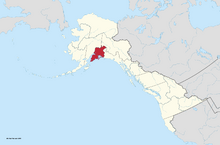| ||||||||
| Capital | Nadezhda | |||||||
| Largest City | Nikolayevsk-Amerikansky | |||||||
| Other Cities | Valdes, Vasilla, Voskresensk | |||||||
| Language Official |
Russian | |||||||
| Others | Dena'ina, German, Norwegian | |||||||
| Religion Main |
Eastern Orthodox Church | |||||||
| Others | Lutherans, Old Believers | |||||||
| Ethnic Groups Main |
Russians | |||||||
| Others | Dena'inas, Germans, Norwegians | |||||||
| Demonym | Kenaian, Kenayets | |||||||
| Governor | Lavrenty Leman (Evergreens) | |||||||
| Area | 111,975 km² (98,391 кв. врс) | |||||||
| Population | 4,420,919 (2017 Census) | |||||||
| Established | 1945 | |||||||
| Admission | 1945 | |||||||
| Time Zone | AKWST (UTC-10) | |||||||
| Summer | AKWDT (UTC-9) | |||||||
| Abbreviations | AK-KE, Кен. (Ken.) | |||||||
Kenai (Russian: Кенай, Kenay), officially referred to as the Governorate of Kenai (Кенайская губерния, Kenayskaya guberniya), is a governorate of Alaska. The governorate encompass all of the Kenai Peninsula. Kenai borders New Irkutsk and Yukon in the north, Yakutat in the east, and a maritime border with Kodiak in the south.
The Russian Empire began to established trading posts on the Kenai Peninsula during the 18th Century. The region's economic importance resulted in a population boom under Russian rule. Kenai became a haven for White Émigrés and diehard Christians (including the Old Believers of the Eastern Orthodox Church). In recent decades, the governorate has become the southernmost hub for the Trans-Alaska Pipeline. Though the oil revenue has seen an economic boom in Kenai, controversies have also persisted. The most noted incident was the 1989 Exxon Valdez oil spill, in which approximately 900,000 barrels of crude oil spilled into the Prince William Sound.
| |||||||||||||||||||||||
![]() This Russian America related article is a stub. Please add suggestions on the talk page.
This Russian America related article is a stub. Please add suggestions on the talk page.




